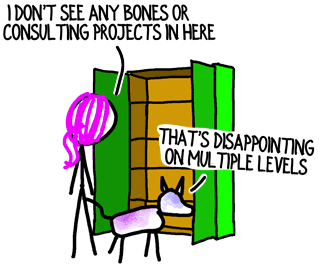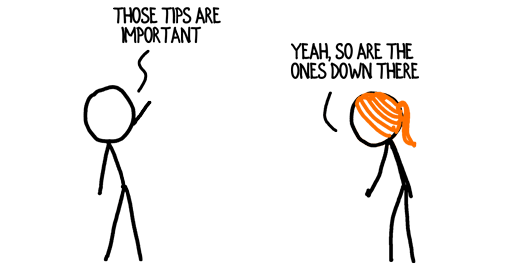When your consulting firm’s sales are down and your pipeline resembles Mother Hubbard’s cupboard, it’s easy to become paralyzed or confused by next steps.

First, determine which variety of sales slump you’re facing. The three types are outlined in this article.
Your consulting firm’s path out of the downturn depend upon which variety of sales slump you’re facing.
However, regardless of the cause of your dip in revenue, there are Dos and Don’ts that always apply.
My team and I compiled a drawer full of Dos and Don’ts then pulled out a stack in each category for this article. Add your ideas below (in the comments section), then pack the lists away into your Consulting Firm First Aid Kit for when you need them.
10 Dos and Don’ts for Consulting Firm Sales Slumps
10 Dos
10 Don’ts
Connect daily to your wins
(Maintain confidence and positive energy)
Panic
Slow down your sales process
(Rushing and pushing lowers Trust)
Push harder to win the sale
Take bread-and-butter work
Take bad work
Break down projects into smaller, lower-risk chunks
Cut your fees
Offer pilot projects
Offer sales incentives

Subcontract
Sign with bad clients
Invest in marketing
Cut your marketing activity
Research to understand your market even better
Fall for silver-bullet quick fixes
Massively increase your networking
Tell the world you’re desperate for business
What else? Suggest a Do
What else? Suggest a Don’t
You have probably accumulated some rules of thumb for your own consulting firm–borne either from success or from hard knocks.
Based on your experience, what other tips would you give a consulting firm leader facing a sales slump?
Text and images are © 2024 David A. Fields, all rights reserved.

 David A. Fields Consulting Group
David A. Fields Consulting Group 

This is wonderful. Would you be so kind David as to elaborate on offering pilot projects and specifically how to communicate when networking?
Or might you have links to your smart advisory that you have already written?
I thank you. I respect your guidance.
Fair questions, Michael. The very short answer about how to communicate when networking is to stay Right-Side Up. Make the conversation about them, not you. There are, literally, dozens of articles on the site about how to communicate when networking, plus, of course, this book. Start with the book, and focus on the mindset–your communication’s impact flows from your mindset and intent, not from your words.
Re a pilot, take a look at this article from 2017: How to Win the 1st Project with a New Consulting Client. Some of the consultants at a firm I was with yesterday call their pilot a “shoe box,” and described it as an easy way for clients to “try our firm on.” That’s an apt description and might help you think about how you can construct your own shoe box.
Thank you for asking the smart, follow-up questions, Michael!
Thank you. I’ve read the book! I didn’t think about Right-Side Up thinking when networking (although I naturally lean that way) so thank you for the helpful reminder!
And thank you for the link. I will definitely read it. Thank you, David!
Appreciate you.
You betcha, Michael. Right-Side Up Thinking applies everywhere in your consulting practice. Everywhere. The tricky part is how to apply it.
What a throwback to your early days in a shoe store, David! The only thing askew with the analogy above is that nobody (except curious kids) will try on a shoe box – rather the shoes inside…
That’s so funny, Franziska. (And double bonus points for you on the shoe store reference!) I’ll slightly adjust the metaphor when I borrow it for a future article…. though the idea of trying on shoe boxes does add a certain, sticky image!
I always appreciate hearing from you, Franziska.
Great, as always. Glad to see increasing networking as a do. My current slump is accompanied by reduced networking activity. Challenge is networking is not a quick fix. Sure, it is possible my existing network has a contact with an immediate need. It all depends on the value I provide with those in my network. Be a giver and provide value. It will come back to you. I just need to remind myself my biggest client came from my network and to focus on the DO column above.
Right you are, Christian. The encouragement I’d add is to grow your network, particularly your Network Core. The more people you are able to touch base with, the more likely you are to encounter someone who says, “You know, I’m glad you called. I was just thinking I need your help…”
I appreciate your sharing the situation you’re in, Christian, and your commitment to sticking with it.
Love this little article – especially point 1, connecting to your wins. We’ve just come out one full-on full-time project, and picking back up with new prospects naturally takes a little time.
I’m looking back right now at the projects I have completed, and even more looking at the feedback from those clients, as they have described the impact we had.
Feels wonderful, and helps me to relax and enjoy the quieter time while it lasts!
Congratulations on the wins, Ben. You’re absolutely right to revel in them. In addition to buoying your spirits, the confidence you feel will help you win your next project. (Some other time we can discuss the pros and cons of taking “full-time” projects.)
Plus, while you’re taking a breather between projects, you can read and comment on more articles! 😉
Seriously, I’m glad you chimed in, Ben.
Use the lull to create new content, address process gaps, learn or get up to speed on new trends and tools in your consulting space, clean your desk.
Very smart advice, Derek. I like that you left “clean your desk” for last. For some consultants, that’s truly a sign of desperation! Many of our clients use lulls in the business to have their consultants research new markets, improve their processes and streamline their approaches. They’re well positioned to expand their search for business, and when new engagements come in, they’re able to complete the work more efficiently and profitably.
Excellent contribution, Derek!
I’m in one now – a natural trough – and in addition to focusing on the steady drumbeat of outreach and visibility activities Im doing what I think of as Closet Cleaning. Just like those occasional dips in personal schedules that allow you to finally tackle the closet you’ve been shoving things into to get them out of your way, I find that when Im busy with client work I shove low urgency items into a mental closet to get to later. So this week I’m going through the file of articles I wanted to keep track of for future use, getting them into my virtual notes engine where I can find them faster when a contact or client might need them. I’m updating my templates and frequently used slides. I’m tackling a systems project that’s been frustrating me but not enough to tacle it in the moment. And while I’m doing all of this it’s reminding me of connections or ideas that I can use to make outreach more personal. Then, when client work picks up again I have space in the closet to store things until the next opening in my schedule!
That’s a lovely metaphor, Jen! Keeping a someday/maybe list that you can turn to when the scramble of delivery is light, is smart. When business and finances are a little rosier, you can also add people who can turn those someday/maybe items to done tasks before they gather dust in the mental closet.
Thank you for the outstanding contribution and metaphor, Jen!